
Original Link: https://www.anandtech.com/show/1821
AMD's Fab 36 Grand Opening - 90nm and 300mm in Germany
by Anand Lal Shimpi on October 14, 2005 7:50 AM EST- Posted in
- CPUs
After 24 months of construction, today AMD's first 300mm semiconductor fab, Fab 36, celebrates its grand opening. Built adjacent to AMD's 200mm Fab 30 in Dresden, Germany, Fab 36's grand opening takes place 6 years after Fab 30's introduction. The name Fab 36 comes from its existence 36 years after the founding of AMD.
The announcement for Fab 36's site in Dresden came in November 2003, with first ground breaking at the end of that month. Approximately 12 months later, the building was ready for equipment, and another 12 months after that, Fab 36 began preparations for mass production.
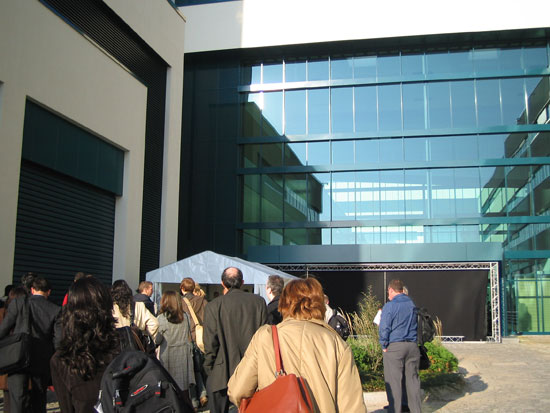
Over 150 members of the press enter AMD's press conference at Fab 36 in Dresden
Unfortunately, at its grand opening, Fab 36 is still a 90nm-only fab; throughout the next year, AMD will begin the transition to 65nm production. The first CPUs built at Fab 36 will be shipping in the first quarter of 2006, with the first 65nm chips leaving Fab 36 by the end of 2006.
Sometime in 2007 AMD will have performed a "substantial amount" of the transition of Fab 36 to a 65nm semiconductor fab, bringing the grand total for the cost of Fab 36 to an astounding 2.5 billion US dollars. There is no word when Fab 36 will be completely converted to 65nm manufacturing.
By 2008, Fab 36 will be able to produce more than 2x the number of processors as Fab 30 (potentially 100M processors per year based on current die sizes).
The first 300mm wafer produced at Fab 36 actually took place back in March, but preparation for mass production continues up to and beyond today. Today's grand opening of Fab 36 marks a huge step in AMD history, as it will hopefully alleviate a number of the supply issues they have been plagued with in recent history.
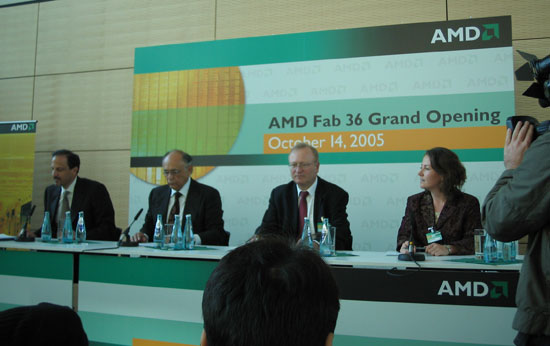
The two individuals in the middle kicked off the day at Fab 36, AMD's CEO, Dr. Hector Ruiz is the second on the left, and VP/GM of AMD Dresden, Dr. Hans Deppe is to the right of Dr. Ruiz.
The day started off with a press conference kicking off the grand opening of the fab. Below we've got a picture of a clean room engineer (or someone dressed as one) posing with AMD's Dr. Hans Deppe, the Corporate VP and General Manager of AMD in Dresden.
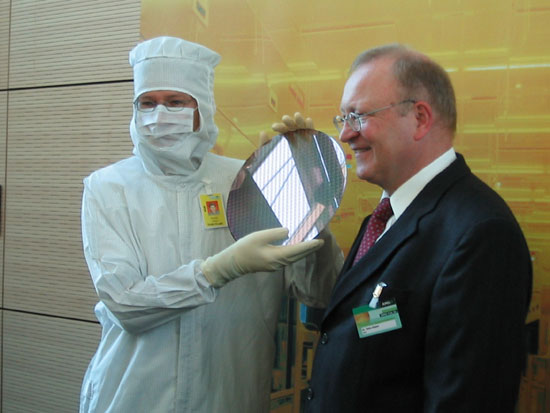
While we don't have a 200mm wafer here to compare sizes with, imagine the wafer pictured above, but smaller.
After some brief words about the opening of Fab 36, a brief Q&A period started. One of the first questions was what will happen to Fab 30 in the future now that Fab 36 is ready to start mass production. Dr. Ruiz mentioned that Fab 30 could be used for more x86 microprocessor production, it could potentially become a chipset manufacturing fab (possibly indicating AMD's intentions to eventually return to chipset manufacturing), or it could be upgraded to future semiconductor technologies for use in the future (e.g. 65nm).
One other important question that was asked was "why Dresden" for Fab 36, to which the answer was obviously multi-faceted:
1) First and foremost, AMD has invested a lot in the people of Dresden, when it comes to training and expertise in semiconductor manufacturing. It was simply easier to leverage the existing human investment.
2) Obviously government subsidies played a large role in AMD's decision to bring Fab 36 to Dresden. Dr. Hans Deppe listed the total amount of government subsidies for Fab 36 as 500 million US dollars.
The final question of the press conference was about AMD's future fab plans, which Dr. Ruiz answered with a timeframe of 2008 for the start of production on the next major fab plant.
AMD Draws a Crowd: German Chancellor Schröder Arrives
After the initial press conference we took a short bus ride to an outside tent where both Dr. Deppe and Dr. Ruiz gave a few words about Dresden and Fab 36, before handing the mic off to German Chancellor Gerhard Schröder.
One point to note was the constant mentioning of "fair competition" in all of Dr. Ruiz speeches, obviously referring to AMD's recent lawsuit against Intel. Dr. Ruiz also mentioned AMD's 50-by-15 goal; that by 2015, 50% of the world will be "connected", partially in thanks to an increase in production of AMD's products. Intel has also outlined their plans for 2015, which we've covered in the past.
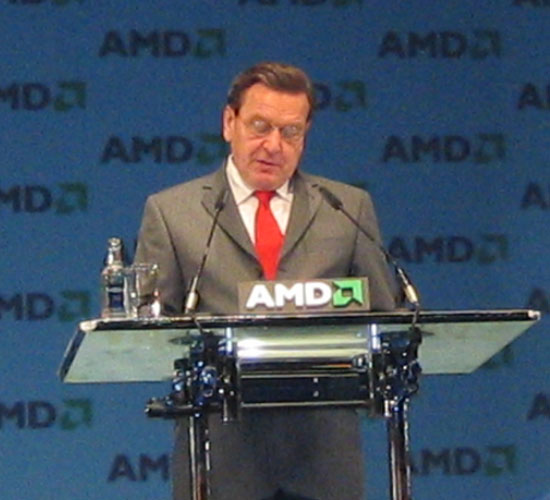
German Chancellor Gerhard Schröder
Chancellor Schröder also made it a point to mention the importance of such a large investment in Dresden, being a part of former East Germany, while stressing that the incoming German government should make it a point to encourage similar investments in the future.
Chancellor Schröder also briefly touched on the topic of fair competition and how Germany's cooperation with AMD has been in the spirit of fair competition, also clearly in reference to AMD's recent lawsuit.
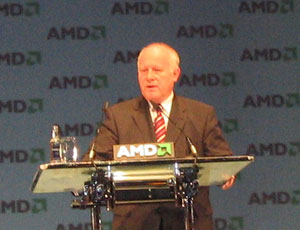
Governer of Saxony, Professor Dr. Georg Milbradt
Dresden is located in the German state of Saxony, and next up was the Governer of the State of Saxony, Professor Dr. Georg Milbradt. Professor Milbradt spoke of the history of Saxony from its humble beginnings to being a center for semiconductor manufacturing thanks to companies like AMD and Siemens.
Professor Milbradt's speech also took a political tone, as he stressed the importance of the new federal government to do even more to encourage investments such as AMD's in Dresden. He stressed that the investments are necessary in order to make Saxony and Dresden competitive in the EU and in the world.
Both Milbradt and Schröder hinted that AMD should definitely consider Dresden for their next fab plant, which Dr. Ruiz mentioned could potentially begin construction as early as 2008.
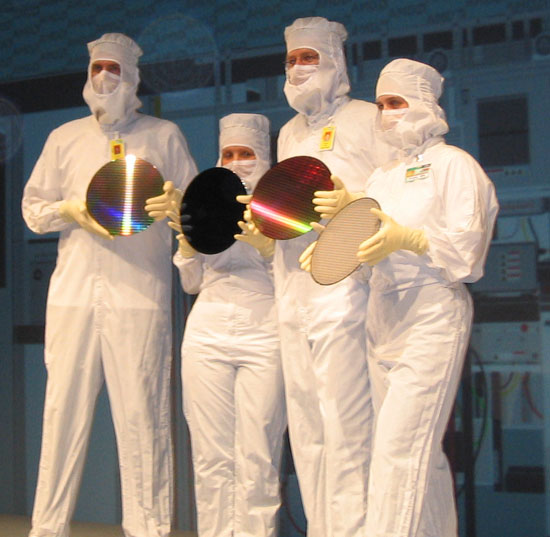
More 300mm wafers, we counted at least 5 today, that should be enough for at least a few Athlon 64 X2s.
The speeches were concluded with a ceremonial "raising of the wafer" as a 300mm wafer rose from the stage and was presented to Dresden, the state of Saxony and Dresden.
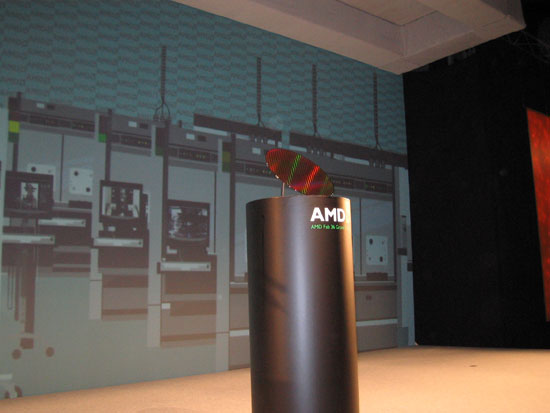
The events at Fab 36 in Dresden are just beginning, we're about to head to a Q&A session followed by some technical tracks and tours of the new plant.
AMD is hopefully going to present us with their future plans later today, which we've been looking forward to ever since Intel's IDF announcements. We'll see if AMD can deliver a more interesting look at their future than the ambiguity that we've been given in the past; stay tuned.







